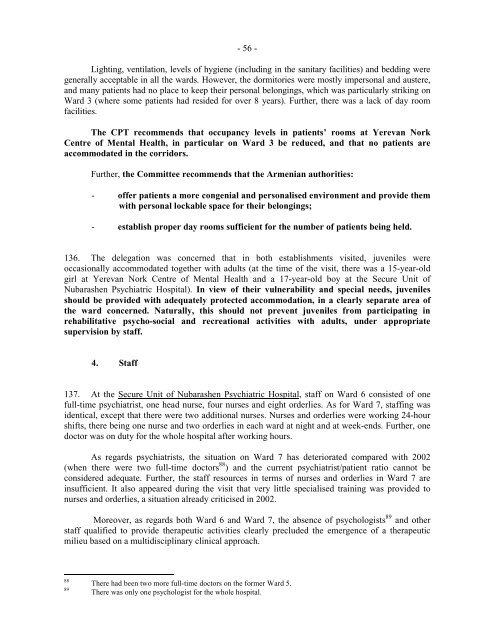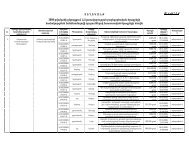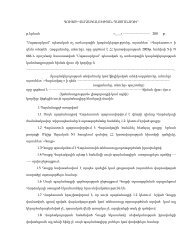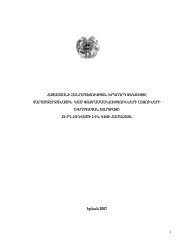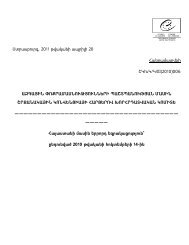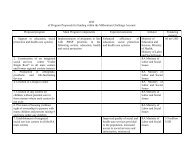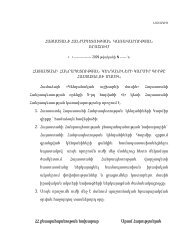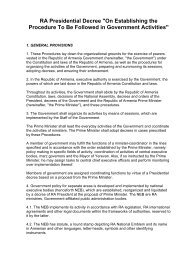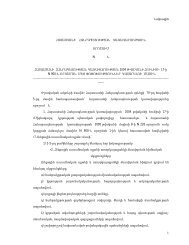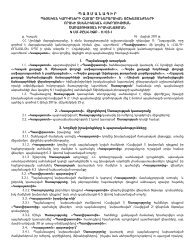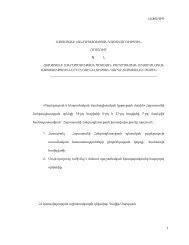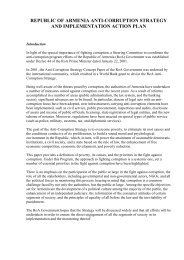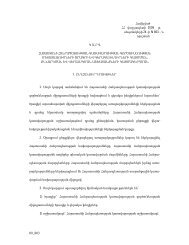- 56 -Lighting, ventilation, levels of hygiene (including in the sanitary facilities) and bedding weregenerally acceptable in all the wards. However, the dormitories were mostly impersonal and austere,and many patients had no place to keep their personal belongings, which was particularly striking onWard 3 (where some patients had resided for over 8 years). Further, there was a lack of day roomfacilities.<strong>The</strong> <strong>CPT</strong> recommends that occupancy levels in patients’ rooms at Yerevan NorkCentre of Mental Health, in particular on Ward 3 be reduced, and that no patients areaccommodated in the corridors.Further, the Committee recommends that the <strong>Armenia</strong>n authorities:- offer patients a more congenial and personalised environment and provide themwith personal lockable space for their belongings;- establish proper day rooms sufficient for the number of patients being held.136. <strong>The</strong> delegation was concerned that in both establishments visited, juveniles wereoccasionally accommodated together with adults (at the time of the visit, there was a 15-year-oldgirl at Yerevan Nork Centre of Mental Health and a 17-year-old boy at the Secure Unit ofNubarashen Psychiatric Hospital). In view of their vulnerability and special needs, juvenilesshould be provided with adequately protected accommodation, in a clearly separate area ofthe ward concerned. Naturally, this should not prevent juveniles from participating inrehabilitative psycho-social and recreational activities with adults, under appropriatesupervision by staff.4. Staff137. At the Secure Unit of Nubarashen Psychiatric Hospital, staff on Ward 6 consisted of onefull-time psychiatrist, one head nurse, four nurses and eight orderlies. As for Ward 7, staffing wasidentical, except that there were two additional nurses. Nurses and orderlies were working 24-hourshifts, there being one nurse and two orderlies in each ward at night and at week-ends. Further, onedoctor was on duty for the whole hospital after working hours.As regards psychiatrists, the situation on Ward 7 has deteriorated compared with 2002(when there were two full-time doctors 88 ) and the current psychiatrist/patient ratio cannot beconsidered adequate. Further, the staff resources in terms of nurses and orderlies in Ward 7 areinsufficient. It also appeared during the visit that very little specialised training was provided tonurses and orderlies, a situation already criticised in 2002.Moreover, as regards both Ward 6 and Ward 7, the absence of psychologists 89 and otherstaff qualified to provide therapeutic activities clearly precluded the emergence of a therapeuticmilieu based on a multidisciplinary clinical approach.8889<strong>The</strong>re had been two more full-time doctors on the former Ward 5.<strong>The</strong>re was only one psychologist for the whole hospital.
- 57 -<strong>The</strong> <strong>CPT</strong> recommends that the <strong>Armenia</strong>n authorities take steps at the Secure Unit ofNubarashen Psychiatric Hospital to:- increase the number of psychiatrists, nurses and orderlies on Ward 7;- provide nursing staff with specialised (initial and ongoing) training inpsychiatry, including relating to patients’ rights;- employ specialists qualified to provide therapeutic and rehabilitative psychosocialactivities (e.g. psychologists, occupational therapists, psychotherapists andsocial workers).138. At the time of the visit, there were 88 staff members at Yerevan Nork Centre of MentalHealth, including 14 full-time psychiatrists, four head nurses, 32 nurses and 32 orderlies (allemployed on a full-time basis). On each ward, there were two psychiatrists and one head nursepresent during the day, and one nurse and two orderlies working 24-hour shifts. As regards otherstaff qualified to provide therapeutic activities, there were three psychologists, one occupationaltherapist and two social workers.<strong>The</strong>re were no vacant posts at the time of the visit and the psychiatrist/patient ratio could beconsidered sufficient. However, as regards nurses, staffing levels were inadequate. Further, therewas scope for a greater contribution from clinical psychologists, occupational therapists and socialworkers, with a view to strengthening the multidisciplinary approach. <strong>The</strong> <strong>CPT</strong> recommends thatthe <strong>Armenia</strong>n authorities take steps at Yerevan Nork Centre of Mental Health to:- increase the nursing staff/patient ratio on the wards;- reinforce the team of specialists qualified to provide therapeutic andrehabilitative psycho-social activities.5. Treatment139. In both establishments, the treatment provided to patients was mainly based onpharmacotherapy. <strong>The</strong>re was no evidence of overmedication. Further, the supply of basicpsychiatric medication appeared to be adequate. Patients were seen by a psychiatrist on a regularbasis and observations were recorded in the patient’s file; however, no individual treatment planswere in evidence in the records examined in either of the establishments.140. In Nubarashen Psychiatric Hospital, it became clear during the visit that rehabilitativepsycho-social activities were still lacking and there was no evidence of a multidisciplinary clinicalteam approach. As a result of the paucity of structured therapeutic activities, the majority of patientsspent most of the time locked up in their dormitories, lying on their beds or wandering idly around.This monotonous existence was broken only by meals, outdoor exercise and watching TV in thewards corridors. As regards in-room activities, they consisted of board games, reading books andnewspapers brought by families and – for patients who could afford one – watching their own TV.
- Page 1 and 2:
Strasbourg, 1 December 2010SecretCP
- Page 3 and 4:
- 3 -D. Prison Service establishmen
- Page 5 and 6: - 5 -Copy of the letter transmittin
- Page 7 and 8: - 7 -B. Establishments visited3. Th
- Page 9 and 10: - 9 -6. As emphasised by the CPT in
- Page 11 and 12: - 11 -II.FACTS FOUND DURING THE VIS
- Page 13 and 14: - 13 -13. The case of Vahan KHALAFY
- Page 15 and 16: - 15 -In the CPT’s view, professi
- Page 17 and 18: - 17 -All these steps permitted the
- Page 19 and 20: - 19 -In order for the Committee to
- Page 21 and 22: - 21 -33. With respect to the right
- Page 23 and 24: - 23 -38. The CPT is pleased to not
- Page 25 and 26: - 25 -B. Military establishments1.
- Page 27 and 28: - 27 -The CPT trusts that the Armen
- Page 29 and 30: - 29 -55. In the light of the above
- Page 31 and 32: - 31 -D. Prison Service establishme
- Page 33 and 34: - 33 -65. In the establishments vis
- Page 35 and 36: - 35 -71. At Yerevan-Kentron Prison
- Page 37 and 38: - 37 -4. Foreign prisoners75. Durin
- Page 39 and 40: - 39 -83. In the CPT’s view, the
- Page 41 and 42: - 41 -Further, the Committee recomm
- Page 43 and 44: - 43 -6. Health carea. health-care
- Page 45 and 46: - 45 -107. The CPT wishes to recall
- Page 47 and 48: - 47 -e. Yerevan Prison Hospital’
- Page 49 and 50: - 49 -f. suicide prevention117. Sui
- Page 51 and 52: - 51 -121. The procedure contained
- Page 53 and 54: - 53 -126. Several remand prisoners
- Page 55: - 55 -133. The Secure Unit of Nubar
- Page 59 and 60: - 59 -6. Means of restraint144. For
- Page 61 and 62: - 61 -148. The delegation’s findi
- Page 63 and 64: - 63 -F. Social care homes1. Prelim
- Page 65 and 66: - 65 -159. Concerning food, the del
- Page 67 and 68: - 67 -The CPT recommends that the A
- Page 69 and 70: - 69 -APPENDIX ILIST OF THE CPT'S R
- Page 71 and 72: - 71 -Investigations into cases pos
- Page 73 and 74: - 73 -- verbal information on right
- Page 75 and 76: - 75 -- the Armenian authorities to
- Page 77 and 78: - 77 -comments- the CPT trusts that
- Page 79 and 80: - 79 -- appropriate steps to be tak
- Page 81 and 82: - 81 -Health carerecommendations- t
- Page 83 and 84: - 83 -comments- the CPT trusts that
- Page 85 and 86: - 85 -requests for information- cla
- Page 87 and 88: - 87 -- steps to be taken at both e
- Page 89 and 90: - 89 -Social care homesIll-treatmen
- Page 91 and 92: - 91 -comments- the Armenian author
- Page 93 and 94: - 93 -B. OTHER AUTHORITIESProsecuto
- Page 95 and 96: Instruction #Ց-2 dated 29.01.2009
- Page 97 and 98: was brought in by the court of firs
- Page 99 and 100: As a result of the facts of various
- Page 101 and 102: The right of inerrogation of a witn
- Page 103 and 104: The departmental network is being i
- Page 105 and 106: Respective measures have been taken
- Page 107 and 108:
Review of criteria for serving the
- Page 109 and 110:
In cases of non-performance of the
- Page 111 and 112:
mentioned establishment does not pr
- Page 113 and 114:
The problem of overcrowding exists
- Page 115 and 116:
een taken by the Penitentiary Servi
- Page 117 and 118:
facilities, closed, semi-closed and
- Page 119 and 120:
causes certain difficulties in prov
- Page 121 and 122:
Medical units of penitentiary estab
- Page 123 and 124:
appropriate, sentenced prisoners ar
- Page 125 and 126:
Armenia; pursuant to the Decision o
- Page 127 and 128:
In connection with paragraph 122 of
- Page 129 and 130:
liable in the manner prescribed by
- Page 131 and 132:
esidents by the staff is punishable
- Page 133 and 134:
Order of the residents’ admission
- Page 135 and 136:
Termination of“Erebouni”functio
- Page 137 and 138:
հոդվածի համաձայն, ք
- Page 139 and 140:
Հասարակական կարգի
- Page 141 and 142:
ՀՀ ոստիկանության հ
- Page 143 and 144:
Ինչ վերաբերում է բե
- Page 145 and 146:
ՀՀ կառավարության 05.
- Page 147 and 148:
ոստիկանության անձն
- Page 149 and 150:
ՈՒսումնասիրելով այ
- Page 151 and 152:
դատապարտյալներ, ին
- Page 153 and 154:
Զեկույցի 69-րդ և 70-րդ
- Page 155 and 156:
տեսակցությունների
- Page 157 and 158:
Ինչ վերաբերվում է հ
- Page 159 and 160:
զբոսանքի կազմակերպ
- Page 161 and 162:
լոգանք ընդունելու
- Page 163 and 164:
ՀՀ ԱՆ ՔԿՎ բժշկական
- Page 165 and 166:
կանոնները, հիվանդն
- Page 167 and 168:
դատապարտյալը կատար
- Page 169 and 170:
ծառայության կալանա
- Page 171 and 172:
• ՀՀ ԱՆ հրավերով Ֆր
- Page 173 and 174:
Բնակելի մակերեսով
- Page 175 and 176:
Հարազատների հետ կա
- Page 177 and 178:
ՀՀարդարադատության
- Page 179 and 180:
ՙՎարդաշեն՚Գործուն


